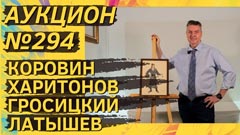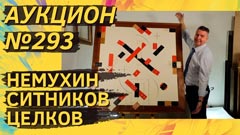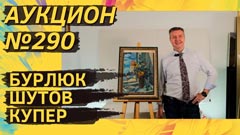
1960s UNOFFICIAL ART
NEIZVESTNY Ernst Iosifovich (1925–2016) Steel soul. 1980. Oil on canvas. 100 × 80
A one-meter canvas, a main theme and a ringing title: “Steel Soul”. An unquestionable museum level. Neizvestny is one of the main representatives of unofficial post-war art. A legend. We are corrected to say that the author of the 75 meter high Lotus Flower monument in Egypt was not an ideological dissident in the 1960s or 1970s. He considered what the Soviet authorities were doing as excesses and subversion of local blockheads. He tried to explain the essence of art and to teach party instructors — what if they come to their senses? But if we look at the facts, who dared to argue with Khrushchev in the Manezh in 1962? Who dared to confront his ministerial retinue, including the KGB? Who was prevented from working after this incident? And who ultimately chose to emigrate from the USSR? “Steel Soul” belongs to the fertile period of Neizvestny's first years in exile, a period in which he was able to reproduce in material many of the ideas that were conceived in his homeland. The authenticity of the painting was confirmed by the artist's daughter, Olga Neizvestnaya.
SVESHNIKOV Boris Petrovich (1927–1998) May flight. 1983. Oil on canvas. 80 × 65
Again, an unconditional masterpiece, that belongs in a museum. Sveshnikov 1983. During this period, his pictorial divisionism reached the highest level of detailed elaboration. Hence the softness of color transitions, which can be felt from a meter away. Hence this particular palette, where blue and green form a pearlescent sheen. But the main thing, of course, is the subject. Sveshnikov is true to himself: his “May flight” is not devoid of anxious anticipation. But at the same time, the picture came out rather soft and romantic by his standards, without otherworldly fauna. This is a rarity. And some of the collectors are hunting for exactly such subjects.
The artist Sveshnikov miraculously did not perish in Stalin's camps. Arkady Steinberg, the camp paramedic and father of Boruch and Eduard Steinberg, pulled him out of that world. After his release, Sveshnikov was able to return to Moscow and worked in book illustration — designing European prose and poetry. Today, Sveshnikov's drawings and paintings are among the most valuable legacy of post-war unofficial art.
GROSITSKY Andrey Borisovich (1934–2017) Detail on brown. 2002. Oil on plywood. 117 × 76
“Detail on brown” is classic Grositsky. Exemplary. “Poetry of things” as it is. Again, a museum-level, meter-sized work with an exhibition history. The contours of the piece, as Grositsky liked to do, are taken out of the plane of a rectangular pictorial base — a technically difficult technique, but amazingly effective and convincing.
Grositsky is an artist we recommend for inclusion in an investment collection. Prices for his work have risen markedly in the last two years. And the quality of the offer still makes it possible to buy select pieces.
Grositsky was not a member of famous non-conformist art groups and schools. But he is unequivocally an artist of the orbit of unofficial art. He was a participant of a group exhibition at the “House of Culture” pavilion at VDNKh in 1975. Since 1976, he has exhibited at the City Committee of Graphic Art at 28, Malaya Gruzinskaya Street. At the end of his life, Grositsky's exhibitions were held at the Tretyakov Gallery and several leading museums in the country.
CONTEMPORARY ART
VOLIGAMSI Rinat (1968) Walk in the fog. 2002. Oil on canvas. 68 × 80
Warm, valve absurdism. The subtle, ironic Voligamsi with yet another “crazy tale of Russian life” (this was the title of a review of one of his exhibitions by Elena Fedotova). Let's remind. Voligamsi is generals' trousers with stripes saluted by frightened officers. A granny feeding crumbs to tyrannosaur pigeons. The constellation of the Big Bear from the stars on the soldiers' caps. Voligamsi's handwriting of the valuable period is a postmodern plot built on gradations of absurdity. Sometimes harsh, sometimes softer. We have the second scenario. In front of us there is a horseman in a field jacket on a horse, melting in the fog. And on his back the rider suddenly has wings. Not like the winged Polish hussars, but rather like a giant dragonfly. So, what is that? And why?
Voligamsi was born and educated in Bashkiria. He began his march on Moscow 20 years ago. That is, the rise of his career took place right before our eyes. His works are already in museums. He is a Kandinsky Prize nominee. Collectors are vying for his works. And he is certainly an artist we recommend for inclusion in investment collections.
KHAMDAMOV Rustam Usmanovich (1944) Russian beauty. 2017. Paper on cardboard, sauce, oil, gouache, felt-tip pen, mixed media. 40.5 × 31.5
Aesthetic, virtuosic Khamdamov. Swift, precise, harmonious. One cannot take one's eyes off it. A little masterpiece by the beloved artist Lucchino Visconti and Tonino Guerra. Khamdamov's works are already in the collection of the Hermitage, the Tretyakov Gallery and the Norton Dodge collection (the Zimmerli Museum). Collectors should definitely vie for this piece.
GINTOVT Alexey Yurievich (1965) Vive la France! 2001. Paper, printing ink. 86 × 61
“Vive la France!” by the philosopher and artist Alexey Gintovt is a blood-chilling work. After all, its protagonist is Mademoiselle Guillotine, not yet cooled down from its routine work. It was invented long before the French Revolution, in Scotland, and for a long time called the Scottish Maiden. But it was the French physician Joseph Guillotin who made it famous. The improved instrument of death was conceived as an act to humanize the death penalty. Guillotin believed that such a terrible means of mechanization removes the risk of executioner's mistakes and thus quickly ends the agony of the condemned. After a short debate and experimentation, the execution by guillotine became the only form of capital punishment permitted by law.
What happened next — everyone knows. In the age of terror of the French Revolution, the guillotines worked without a rest. And it did not matter who lay on the bench — a villain or an aristocrat, whose only fault was that he belonged to the nobility. In one day, the executioners contrived to behead a hundred people. Guillotin's descendants had to change their surname to avoid associations with the monstrous practice. Contrary to the popular opinion, the guillotine was a standard instrument of execution not only in France, but also in Germany. In particular, the Nazis executed Musa Jalil in such way. For the last time the execution by guillotine was made rather recently — in 1977, in France. It is believed to be the last execution in Western Europe.
RUSSIAN AVANT-GARDE
ROZHDESTVENSKY Konstantin Ivanovich (1906–1997) With a fan. Mid 1930s. Lead pencil, gouache on paper. 24 × 20.9
There is a title and signature in initials on the back: “With a fan” / KR. The mat covers also conceal a dedicatory inscription addressed to Valentina Andreevna Otkidach-Pazhinskaya (b. 1945), an art historian, member of the USSR Union of Artists and an honored museum worker.
Recall that Konstantin Rozhdestvensky is a student of Kazimir Malevich. After the avant-garde was actually banned, he was engaged in the design of large exhibitions, including the design of the pavilion at the World Exhibition in Paris in 1937. Rozhdestvensky became a people's artist and an academician. Many people did not even know about his avant-garde period. It was only towards the end of his life that the study of his avant-garde heritage was undertaken by art critics, and a large exhibition in the Tretyakov Gallery was held ten years after the artist's death.
What we have before us is a Rozhdestvensky of the mid-1930s. The avant-garde was already stopped on the run. And in the country, the criteria of peoplehood, ideology and concreteness are being introduced for art.
The authenticity of the work is confirmed by the conclusion of the expert Olga Glebova.
- Log in to post comments










